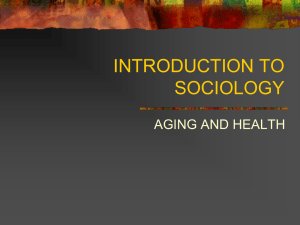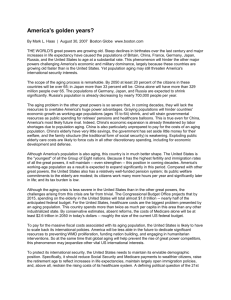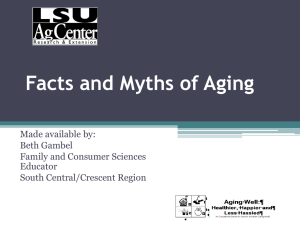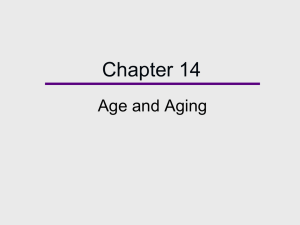An Aging Society - Napa Valley College
advertisement
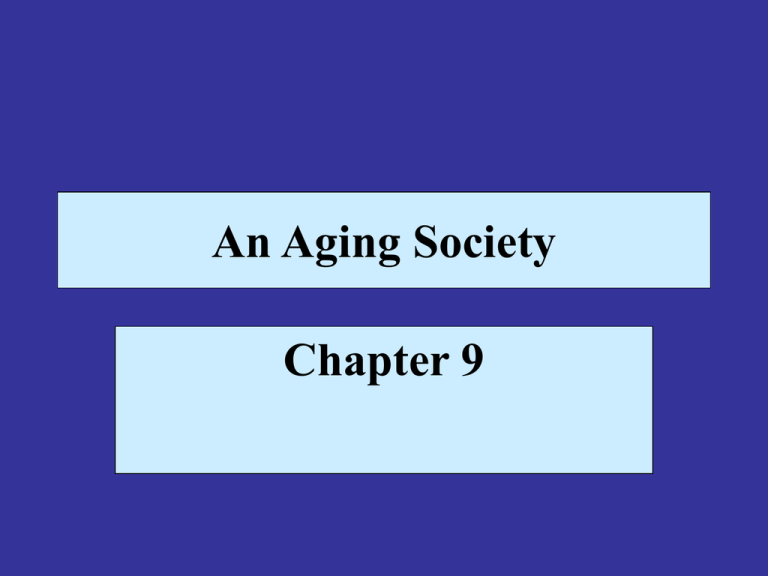
An Aging Society Chapter 9 Aging as a Social Problem • Aging places stress on the individual and society • Long term failure of social institutions to accommodate the elderly • Failure of the family to adapt to presence of older members • Strain on the labor force as careers of the young are blocked by those in their middle years Aging as a Social Problem • Three factors are related to some of the problems of the aged • 1. Labeling, which leads to discrimination and stigmatization of the elderly • 2. The concept of work as the basis of personal value and the impact of retirement • 3. Economic deprivation Perspectives on Aging • Functionalists view aging as a problem because institutions of society are not working well enough to serve the needs of an aging population • Interactionists view the term elderly as a stigmatizing label (ageism) that negatively impacts the elderly in society • Conflict theorists view the problems of the elderly stemming from their lack of power to shape social institutions The Elderly in America Today • Problems of the elderly today are tied to the process of modernization • The transformation of societies into complex urban and industrialized communities • Modernization has led to increased life expectancy » Medical advances » Modern techniques of sanitation and water supply and nutritional intake The Elderly in America Today • Increased life expectancy has also led to more major health problems among the elderly • Urbanization has also led to a shift in the elderly population geographically » Rural elderly in the Midwest and Plains states » Movement of the elderly to Florida and the Southwest Age Stratification • Age stratification – the segregation of the population into various age strata • Limits the roles of different age strata • Age stratification is related to some of the disengagement of the elderly from certain social roles » Work roles as an illustration Age Stratification • Age stratification is also related to age segregation and conflict » Segregated into retirement communities • Intergenerational conflict Who Are the Elderly? • The elderly are a diverse population often broken down into three groups • Young-old - those between the ages of 65 to 75 » Still inclined to be healthy and active • Steady increase in the population over 65 over the next generation » Aging of the baby boom generation • Old-old - those over 75 » More likely to require support services Who Are the Elderly? • Oldest-old - those over the age of 85 • Frail elderly consist of those over 65 because of poor health and economic problems can not care for themselves without help • Two-thirds of the elderly live in urban areas • The elderly often represent a large portion of the population of small towns with out-migration of the young • Elderly migration to the West and South and the formation of retirement communities Who Are the Elderly? • The Uneven Graying of America • The 2000 census revealed that the elderly population is continuing to grow rapidly, it is not evenly distributed over the continent • During the last decade, the most rapid increases in the elderly population were among the oldest of the old, those over 85 Ageism • Ageism is the subordination of and devaluation of the elderly in society • Ageism is reflected in government » Administration on Aging has low status within government » Aging departments are often the subject of budget cuts during lean times Ageism • Ageism is reflected in mandatory retirement » Loss of status » Economic security » Social isolation • Ageism is reflected in the media » Negative portrayal of the elderly • Ageism is also reflected in the high rate of suicide among the elderly Ageism • Ageism is also reflected in the high rate of suicide among the elderly • Suicide among the elderly is related to » Loss of status and income » Poor health » Loss of friend and family relationships and social isolation Dimensions of the Aging Process • Physiological Aspects of Aging • Chronological Aging - simple accumulation of years • Gerontology has emerged as a discipline concerned with studying the aging process Dimensions of the Aging Process • Physiological Aspects of Aging • Primary and secondary aging • Primary aging is the result of molecular and cellular changes » Gray hair » Wrinkling of skin » Weakened immune system » Brain cell loss Dimensions of the Aging Process • Physiological Aspects of Aging • Primary and secondary aging • Secondary aging is caused by environmental factors: » Lack of exercise » Stress » Trauma » Poor diet » Disease Dimensions of the Aging Process • • • • • • Physiological Aspects of Aging Primary and secondary aging Aging is a gradual process Carries a personal timetable Effects of aging are not inevitable Preventative strategies can be used to slow the aging process Dimensions of the Aging Process • Psychological Dimensions of Aging • The psychological effects of aging • The shrinking of one’s social environment » Self-concept » Loss of status » Circle of friends and family grow smaller • The negative label associated with aging impacts the elderly’s well-being Dimensions of the Aging Process • Social and Cultural Dimensions of Aging • The Aged as a Minority Group • Victims of prejudice, stereotyping, and discrimination • Quasi-minority » Potential power of the elderly is enormous Dimensions of the Aging Process • Social and Cultural Dimensions of Aging • Myths and Stereotypes About the Elderly • The elderly are often viewed as » Senile » Lacking individuality » Tranquil » Nonproductive » Conservative and resistant to change Dimensions of the Aging Process • • • • • • Social and Cultural Dimensions of Aging Myths and Stereotypes About the Elderly Myths about older women Health - older women are hypochondriacs Marriage - widowhood is viewed negatively Widowhood - widows base their identities on their dead husbands • The rocking-chair image Concomitants of Aging • • • • • • • Victimization of the Elderly Victims of fraud Victims of crime Elder Abuse At least 1.5 million cases of elder abuse each year Private households Institutional settings Concomitants of Aging • Health Care and the Aged • Chronic illnesses • Growing health care needs and lack of income to afford it • Medicare • Medicaid, of which 35 percent goes towards the elderly Concomitants of Aging • Economic Discrimination • Older workers are targets of job discrimination » Mandatory retirement • Discrimination in looking for jobs » Overqualified • 1967 Age and Discrimination Employment Act » Prohibits discrimination of workers between the age of 40-65 Concomitants of Aging • Economic Discrimination • Multiple Jeopardy • Minority workers often experience double discrimination • Family Problems • Institutional placement is often a difficult decision • A growing number of elderly people are facing the burden of rearing their grandchildren Concomitants of Aging • Retirement • Retirement and the dependency ratio » Non working population that is dependent on those that are working for support • Dependency ratio and the cost of: » Medicare » Social Security Concomitants of Aging • • • • • • • Death Kübler-Ross and the dying process: 1. Denial and isolation 2. Anger and resentment 3. Bargaining and an attempt to postpone death 4. Depression and a sense of loss 5. Acceptance Concomitants of Aging • Death • Hospice - special institutions designed for the terminally ill • Home hospice care • Death with Dignity Social Policy • Housing • Living alone and dealing with isolation and loneliness • Elderly who live with their adult children or relatives do so for financial reasons or declining health • Elderly face limited housing choices Social Policy • Health Care • Growing elderly population in need of health care » Medicare and growing cost • Long-term care • Subsidies for prescription drugs Social Policy • Retirement and Social Security • Social Security benefits are too small for the purposes these subsidies meet • Inequality and social security payments » Low-income workers receive less » Discriminates against women
